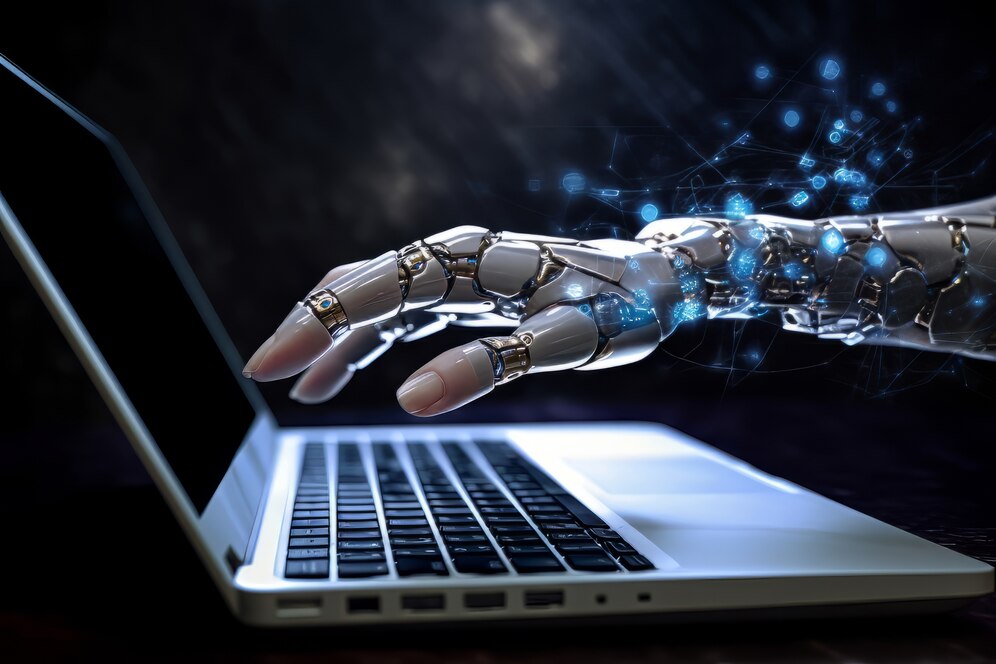
by Huenei IT Services | Sep 11, 2024 | Artificial Intelligence
Serverless: The New Paradigm for Agile and Competitive Companies
Far from being just a trend, serverless architecture is driving a fundamental shift in how businesses approach cost optimization and innovation. This technology is redefining how organizations design, develop, and scale their applications, freeing up valuable resources to focus on their core business.
Alejandra Ochoa, Service Delivery Manager of Huenei, states: “Today, serverless encompasses a complete ecosystem including cloud storage, APIs, and managed databases. This allows teams to focus on writing code that truly adds value to the business, reducing operational overhead and increasing agility. The ability to scale automatically and respond quickly to market changes is essential to stay competitive in an environment where speed and flexibility are crucial.”

Competitive Advantage and ROI
Alejandra Ochoa emphasizes the importance of the serverless cost model: “The accuracy in billing introduced by serverless is revolutionary. By charging only for actual execution time in milliseconds, this ‘pay-per-use’ approach aligns expenses directly with value generated, drastically optimizing TCO (Total Cost of Ownership). This not only impacts operational costs but also transforms financial planning, allowing for greater flexibility and precision in resource allocation.”
This model enables companies to automatically scale during demand spikes without incurring fixed costs during low activity periods, significantly improving their operating margins. This effortless scaling capability is a differentiator in terms of agility, allowing companies to stay competitive in highly dynamic markets.
Challenges and Strategic Considerations
While serverless offers transformative benefits, it’s crucial to address challenges such as cold start latency, potential vendor lock-in, and monitoring complexity. Alejandra Ochoa notes: “These challenges require a strategic approach, particularly regarding the choice of programming languages and platforms.”
For example, cold start times for Java functions in AWS Lambda are nearly three times longer than for Python or Node.js, which is an important factor when choosing a programming language for critical workloads. Similarly, in Google Cloud Functions, cold start times for functions written in Go are considerably longer than for functions in Node.js or Python, which can affect performance in time-sensitive applications.
“Beyond technical challenges,” Ochoa adds, “it’s important to consider the impact on the IT operating model. Transitioning to serverless requires a shift in skills and roles within IT teams. It’s crucial to invest in staff training and process adaptation to maximize the benefits of this technology.”
Synergy with Emerging Technologies
The convergence of serverless with AI and edge computing is opening new frontiers in innovation. This synergy enables real-time data processing and the deployment of more agile and cost-effective AI solutions, accelerating the time-to-market of innovative products. Additionally, the emergence of serverless platforms specialized in frontend development is democratizing full-stack development and enabling faster, more personalized user experiences.
Ochoa provides a more specific perspective on this trend: “In the AI space, we’re seeing how serverless is transforming the deployment of machine learning models. For instance, it’s now possible to deploy natural language processing models that automatically scale based on demand, reducing costs and improving efficiency. Regarding edge computing, serverless is enabling real-time IoT data processing, crucial for applications like monitoring critical infrastructure or managing autonomous vehicle fleets.”
Strategic Impact and Use Cases
Serverless excels in scenarios where agility and scalability are crucial. It facilitates the transformation of monolithic applications into more manageable microservices, improving development speed and market responsiveness. In the realm of IoT and AI, it allows for efficient processing of large data volumes and more agile deployment of machine learning models.
Ochoa shares her perspective on the strategic impact: “In the financial industry, serverless is revolutionizing transaction processing and real-time risk analysis. In healthcare, there’s enormous potential for large-scale medical data analysis, which could accelerate research and improve diagnostics. Furthermore, serverless is redefining how companies approach innovation and time-to-market. The ability to quickly deploy new features without worrying about infrastructure is enabling shorter development cycles and more agile responses to market demands.”
Conclusion
Adopting serverless architectures represents a strategic opportunity for companies seeking to maintain a competitive edge in the digital age. By freeing teams from the complexities of infrastructure management, serverless allows organizations to focus on innovation and delivering real value to their customers.
“For tech leaders, the question is no longer whether to consider serverless but how to implement it strategically,” concludes Ochoa. “This involves not only technical evaluation but also careful consideration of available vendors and technologies, as well as planning for the future evolution of architecture. At Huenei, we are committed to helping our clients navigate this transition and make the most of the opportunities offered by serverless, including its integration with emerging technologies like AI and edge computing.”
 Get in Touch!
Get in Touch!
Francisco Ferrando
Business Development Representative
fferrando@huenei.com

by Huenei IT Services | Jun 4, 2024 | Artificial Intelligence
Generative AI is no longer in the experiment stage. Chief Information Officers (CIOs) are now looking to ramp up these solutions and gain a real edge in the market. However many companies are hitting roadblocks that prevent them from maximizing the potential of
Generative AI.
While the challenges organizations face often fall into common categories, the solutions must be tailored to each company’s unique needs.

Choosing the Right Path
The first step is deciding how your company will integrate these new tools. There are three main options: pre-built tools, custom models with your own data, and building your own large language models (LLMs).
Here are some key factors to consider when making this choice:
- Resources and budget: Pre-built tools are the most cost-effective option but offer less control. Integrating models with your data requires investment in infrastructure and talent. Building LLMs from scratch is the most expensive option, requiring significant resources and cutting-edge expertise.
- Specific needs and use cases: If you only need Generative AI for basic tasks, pre-built tools might suffice. However, if you require highly specialized AI for your core products or services, building custom solutions will provide a greater long-term advantage.
- Data ownership and regulations: In some industries, regulations or data privacy concerns might necessitate integrating models with your data or building solutions in-house.
- Long-term AI strategy: If AI is simply another tool in your toolbox, pre-built solutions might work. But to gain a competitive advantage through AI, you’ll need to develop unique in-house capabilities.
For example, FinanceCorp initially used pre-built Generative AI tools for tasks like writing and summarizing reports. However, these tools proved inadequate for complex financial tasks like risk analysis and contract reviews. To achieve the performance they needed, they had to switch to a custom model solution with their own data.
Taming the Generative AI Beast
One key lesson learned from pilot projects is the importance of avoiding a sprawl of platforms and tools. A recent McKinsey survey found that “too many platforms” was a major obstacle for companies trying to implement Generative AI at scale. The more complex the infrastructure, the higher the cost and difficulty of managing large-scale deployments. To achieve scale, companies need a manageable set of tools and infrastructure.
One solution is to establish a centralized, single-source enterprise Generative AI platform. While this requires initial standardization efforts, it can significantly reduce operational complexity, ongoing maintenance costs, and associated risks in the long run. It also facilitates consistent and scalable deployment of Generative AI across the organization.
A hybrid approach that combines internal and external expertise might be the most effective strategy. Partnering with a leading technology provider can provide a solid foundation for a robust Generative AI platform. However, you’ll also need to build an internal team with expertise in data science, AI engineering, and other relevant fields. This team can then customize, expand, and manage the platform to meet your specific business needs.
For instance, HSBC, after piloting solutions with seven different Generative AI vendors, faced challenges with high maintenance costs, governance issues, and integration complexities. They decided to consolidate everything on Microsoft’s platform and standardize APIs, data flows, monitoring, and other aspects. This approach helped them reduce their AI operating costs by over 60%.
Conquering the Learning Curve
Finally, there’s the ever-present learning curve. CIOs understand the technical skills needed for Generative AI, such as model fine-tuning, vector database management, and application and context engineering. However, acquiring this knowledge can be a daunting process. Building all the specialized skills in-house can be extremely slow and challenging. Even with an accelerated learning curve, it could take months for an internal team to reach the required level of expertise.
Retail giant GiganteCorp allocated a significant budget of $15 million to assemble an elite team of 50 data scientists and engineers with experience in fine-tuning cutting-edge language models, application engineering, and vector knowledge bases. However, due to the high demand for these specialists in the market, they were only able to fill 40% of the positions after a year.
The lack of prior experience and the need to master new technologies can make implementing Generative AI seem like a formidable task. However, by partnering with an experienced technology partner, companies can overcome these challenges and unlock the full potential of Generative AI to transform their operations.
After several failed attempts to develop their own Generative AI models, the legal firm BigLaw partnered with experts from Anthropic. Their guidance in best practices, benchmarking, iterative refinement, and thorough testing enabled their contract review system to achieve over 95% accuracy in less than six months, a 30% improvement over previous attempts.
A specialized Generative AI partner can and should continue to provide ongoing consulting and support services, even after initial capabilities have been implemented within the organization. Inevitably, challenges, bottlenecks, or highly specific requirements will arise as Generative AI usage is deployed and scaled. Accessing the deep expertise of these consultants can be key to resolving them effectively.
The Generative AI models deployed by the fintech company Novo initially yielded excellent results in tasks such as fraud detection and customer support. However, after eight months, performance degradations began to be observed as data patterns shifted. They had to implement continuous data retraining and recycling pipelines to maintain accuracy levels.
In conclusion, Generative AI systems are not one-time projects; they require continuous refinement and updating. Adopting a mindset of constant testing, learning, and improvement based on feedback and empirical data is crucial for maximizing the long-term value of Generative AI.
 Get in Touch!
Get in Touch!
Francisco Ferrando
Business Development Representative
fferrando@huenei.com

by Huenei IT Services | Jun 3, 2024 | Artificial Intelligence, UX & UI Design
Progressive Web Apps (PWAs) are revolutionizing the way businesses deliver web experiences. By merging the best aspects of traditional websites and native mobile apps, PWAs offer a seamless, app-like user experience accessible through any web browser.

The best of two worlds
PWAs work for every user, regardless of the browser they’re using. They provide an enhanced experience for modern browsers that support the latest web standards, while still functioning as a traditional website on older browsers. Can work offline or with poor network connectivity by leveraging service workers, a script that acts as a client-side proxy, and caching app resources and data for offline use.
Also, they are searchable and discoverable through search engines, just like regular websites, providing a wider reach compared to native apps in app stores.
Progressive Web Apps eliminate the need to develop and maintain separate native apps for different platforms (iOS, Android, etc.). A single codebase can target multiple platforms, reducing development and maintenance costs. Unlike native apps, PWAs do not require installation from app stores, making them accessible to anyone with a web browser. They can be updated seamlessly without user intervention, ensuring users always have access to the latest version. This eliminates the need for manual app updates, reducing overhead and ensuring a consistent experience across users.
PWAs can leverage existing web infrastructure and APIs, making it easier to integrate with existing systems and processes within the organization. This can reduce the need for extensive refactoring or migration efforts. Additionally, they can be built using a modular architecture, allowing different components or features to be developed and deployed independently. This can aid in scalability and enable large businesses to incrementally roll out new features or updates.
Overall, PWAs offer businesses a cost-effective, scalable, and user-friendly solution for delivering engaging web experiences across multiple platforms, while leveraging existing web infrastructure and technologies. This can lead to improved user engagement, reduced development and maintenance costs, and better compliance with security and privacy standards.
The AI obsession
Progressive Web Apps can integrate AI technology to provide enhanced functionality and user experiences.
These new applications can leverage NLP to enable voice commands, chatbots, or virtual assistants. This allows users to interact with the app using natural language, enhancing accessibility, and providing a more intuitive user experience.
Also, machine learning algorithms can be integrated into PWAs for various purposes, such as:
- Personalization: Analyzing user behavior and preferences to provide personalized recommendations, content, or experiences.
- Predictive analytics: Predicting user actions, needs, or preferences based on historical data and patterns.
- Image/object recognition: Identifying objects, faces, or features in images or videos within the PWA.
AI can be used to assist users in filling out forms by automatically populating fields based on user inputs or previous data, reducing friction and improving the user experience. Can also analyze user behavior, preferences, and context to deliver highly relevant and personalized notifications at the right time, improving engagement with the PWA.
With the help of technologies like TensorFlow.js, AI models can be integrated into PWAs and run directly in the user’s browser, enabling intelligent features even when the device is offline.
What about data privacy?
Developing an AI-powered Progressive Web App (PWA) that meets stringent privacy standards and complies with certifications like ISO 27001 demands a comprehensive approach. Companies must embrace a “Privacy by Design” mindset from the outset, weaving data protection principles into every phase of development.
Data minimization is key, collecting only essential user information for the AI functionality while providing transparent communication about data usage. Robust data handling measures, including encryption, secure protocols, and fortified storage, safeguard user privacy.
Empowering users with clear consent mechanisms and control over their data fosters trust. Rigorous auditing, logging, and periodic risk assessments maintain accountability and enable swift identification of potential issues.
Adhering to privacy regulations like GDPR and implementing secure AI model training processes further reinforce compliance. Ethical AI principles, such as transparency, fairness, and explainability, underpin the system’s responsible operation.
By integrating privacy and security measures holistically throughout the lifecycle, companies can deliver innovative AI-powered PWAs that prioritize user trust and data protection, setting new standards for responsible technology.
Too good to be true?
Considering the breadth of skills required, it may be challenging for a single team or organization to possess all the necessary expertise. In such cases, finding an experienced partner or consulting firm that specializes in AI-powered development can be a viable option.
An experienced partner can provide:
- Proven expertise and a skilled team with the required technical capabilities
- Established best practices, methodologies, and tools for PWA and AI development
- Experience in navigating regulatory and compliance requirements
- Access to specialized resources and infrastructure
- Ability to scale resources as needed and provide ongoing support and maintenance
PWAs equipped with AI capabilities represent a powerful tool for businesses seeking to deliver a superior user experience, reduce costs, and gain a competitive edge. By partnering with an experienced software development firm, you can leverage this technology while ensuring the highest security and privacy standards are met.
 Get in Touch!
Get in Touch!
Isabel Rivas
Business Development Representative
irivas@huenei.com

by Huenei IT Services | Apr 8, 2024 | Artificial Intelligence, Software testing
The software industry is a relentless sprint.
Development teams face ever-increasing pressure to deliver high-quality solutions at breakneck speed. Traditional testing methods, however, can be slow and cumbersome, acting as a bottleneck in your agile workflow.
At Huenei, we understand this challenge. That’s why we’ve harnessed the power of Artificial Intelligence (AI) to revolutionize our software testing processes. We can help you do the same.

“AI-powered testing tools have been a game-changer for our teams,” says Alejandra Ochoa, Service Delivery Manager at Huenei. “By automating and optimizing various aspects of the testing lifecycle, we’ve been able to significantly reduce the time and effort required to ensure the quality of our software solutions.”
Accelerating Test Automation with AI
One of the key benefits we’ve experienced is the ability to create airtight automated tests up to five times faster than traditional methods. We leverage advanced algorithms and natural language processing (NLP) capabilities, allowing our developers and testers to write automated tests in plain English. This NLP-based scripting approach simplifies the test authoring process and promotes collaboration among team members with varying technical backgrounds.
“The NLP-based scripting feature has been a game-changer for our agile teams,” Ochoa explains. “Our testers can now focus on testing scenarios and leave the technical implementation details to the AI-powered tools, resulting in more efficient and effective test coverage.”
With this remarkable effort decrease in automatic test case generation, we’re empowered to seamlessly integrate automated testing right from Sprint #1 for all new application developments. Plus, as the Sprints unfold, we can effortlessly expand test coverage, ensuring superior quality and coverage every step of the way. And even more benefits, once the software application has been ended, we have full automated testing coverage!
Streamlining Test Execution and Error Detection
But the benefits don’t stop there. AI-powered testing tools have also optimized test execution, reducing build times from hours to minutes. This efficiency translates into faster feedback loops, allowing our development teams to identify and address issues more promptly, ultimately speeding up the delivery of high-quality software solutions to our clients.
Moreover, these tools excel at identifying and diagnosing functional and visual errors that may have gone unnoticed by human testers. By analyzing vast amounts of data and recognizing patterns, AI-powered testing solutions can catch even the most subtle defects, ensuring a more robust and reliable software product for our clients.
Embracing AI in Agile Testing
At Huenei, we’ve fully embraced the integration of AI in our software testing processes, recognizing its potential to enhance our agile development methodologies. From data-driven testing to cross-platform compatibility testing, AI-powered tools provide comprehensive capabilities that enable our teams to work more efficiently and deliver superior results.
“One of the key advantages of AI in our agile testing processes is the ability to continuously learn and adapt,” Ochoa notes. “As AI-powered tools process more data and encounter new scenarios, they refine their algorithms and improve their testing strategies, resulting in more effective and efficient testing over time.”
Empowering Teams with Intelligent Solutions
At the core of our approach is the belief that AI should empower our teams, not replace them. While AI-powered testing tools automate and optimize many aspects of the testing process, human expertise and oversight remain crucial. We strike a balance between leveraging AI capabilities and ensuring that our developers and testers are actively involved, providing valuable insights and making critical decisions.
“We prioritize responsible and trustworthy AI practices,” Ochoa emphasizes. “Our ethical guidelines and principles ensure that our AI-powered testing tools are developed and deployed with fairness, accountability, and transparency in mind.”
By harnessing the power of AI in our software testing processes, we unlock new levels of efficiency, quality, and agility.

by Huenei IT Services | Apr 8, 2024 | Artificial Intelligence
As technology continues its relentless march forward, we are witnessing the convergence of several truly disruptive innovations – WEB3, the Internet of Things (IoT), Artificial Intelligence (AI), and Blockchain. This powerful intersection is shattering boundaries and unlocking unprecedented opportunities for businesses to thrive in the digital age.

Redefining Digital Ownership with WEB3
At the core of this convergence lies WEB3, the next evolutionary leap for the World Wide Web. WEB3 represents a paradigm shift, decentralizing the web and putting control back into the hands of users through blockchain-based ownership of digital assets and data. This democratization disrupts traditional power dynamics, fostering greater transparency, autonomy, and innovation.
In this new realm, businesses can leverage non-fungible tokens (NFTs) and decentralized applications (dApps) to create unique digital assets and experiences for their customers. From tokenized loyalty programs to immersive virtual worlds, the potential for novel engagement models is staggering. Crucially, WEB3 safeguards user privacy and data sovereignty, fostering trust – the bedrock of lasting customer relationships.
Real-Time Intelligence Fueled by IoT
Complementing WEB3 is the Internet of Things, an interconnected ecosystem of physical devices embedded with sensors and software, collecting and exchanging real-time data. This continuous stream of IoT intelligence provides businesses with unprecedented visibility into their operations, assets, and customer behaviors.
By harnessing IoT data, companies can optimize processes, preempt maintenance issues, and deliver hyper-personalized products and services. The possibilities are vast – from predictive maintenance in manufacturing to precision agriculture and smart city initiatives. And when combined with AI, the insights extracted from this data become even more powerful.
AI: The Intelligence Amplifier
Artificial Intelligence acts as a force multiplier, turbocharging decision-making, automation, and personalization across virtually every industry vertical. As the volume and complexity of data grow, AI’s ability to identify patterns, make predictions, and generate insights becomes indispensable.
From supply chain optimization and dynamic pricing models to chatbots and recommendation engines, AI is already augmenting human capabilities and driving operational efficiencies. As the technology continues to evolve, we can expect to see increasingly sophisticated applications in areas like autonomous systems, computer vision, and generative AI – opening new frontiers for innovation.
Blockchain: The Trust Protocol
Underpinning this convergence is Blockchain, the distributed ledger technology that guarantees secure, transparent, and tamper-proof record-keeping. By decentralizing trust and removing intermediaries, Blockchain streamlines processes, reduces costs, and mitigates risks associated with fraud, cybercrime, and counterfeiting.
In supply chain management, for instance, Blockchain enables comprehensive traceability – from raw materials to finished goods, empowering conscious consumers with complete transparency. In finance, it’s revolutionizing cross-border payments, lending, and trading through decentralized finance (DeFi) platforms. In healthcare, it’s fortifying the integrity of electronic medical records and powering secure data-sharing for collaborative research.
Success Stories from the Convergence Frontier
While still in its nascent stages, the convergence of these technologies is already yielding compelling success stories across diverse sectors:
- In fashion, companies like MVFW are leveraging NFTs and virtual runways to engage younger audiences and monetize digital fashion experiences.
- Automotive giants like BMW are exploring Blockchain to create tamper-proof digital histories for vehicles, enhancing trust and transparency.
- DeFi platforms like Aave are using AI to automate loan origination and risk assessment, driving financial inclusion.
- Agriculture leaders like Haylettee are deploying IoT sensors and Blockchain to optimize crop yields while enabling full supply chain transparency.
The examples are endless, spanning retail, manufacturing, energy, transportation, and beyond. However, these are just the opening salvos – the true potential of this convergence has barely been tapped.
Embracing the Convergence
As these powerful technologies continue intertwining, businesses face an inflection point: they can either embrace the convergence or risk obsolescence. By harnessing WEB3, IoT, AI, and Blockchain in unison, forward-thinking organizations can unlock new revenue streams, forge deeper customer relationships, drive sustainable practices, and future-proof their operations.
The convergence isn’t just a technological revolution – it’s a fundamental reshaping of how businesses create and deliver value. And those who take the leap stand to reap immense competitive advantages in this boundary-less frontier. The future belongs to the bold, the innovative, and those willing to ride the convergence wave into uncharted waters of opportunity.

by Huenei IT Services | Apr 8, 2024 | Artificial Intelligence, Software development
The convergence of Artificial Intelligence (AI) and the Internet of Things (IoT) is ushering in a paradigm shift, where intelligent applications and solutions are poised to transform virtually every industry.
This powerful synergy is unlocking new frontiers of real-time data analysis, intelligent automation, and data-driven decision-making, promising to redefine how we interact with the world around us.

Real-Time Data Analysis with AI and IoT
At the core of this revolution lies the ability to harness the vast troves of data generated by IoT devices and extract actionable insights using AI algorithms. IoT sensors and devices, deployed across diverse environments, continuously collect and transmit data on various parameters, ranging from environmental conditions to equipment performance and human behavior.
However, this deluge of data is only valuable if it can be effectively analyzed and translated into meaningful information. This is where AI shines, with its ability to process and identify patterns within vast datasets at unprecedented speeds. By integrating AI with IoT systems, organizations can gain real-time visibility into their operations, enabling proactive decision-making and responsive action.
For instance, predictive maintenance is a prime example of this synergy in action. AI algorithms can analyze sensor data from industrial machinery, detecting anomalies and predicting potential failures before they occur. This not only minimizes downtime and reduces maintenance costs but also enhances safety and extends the lifespan of critical equipment.
Intelligent Task Automation and Decision-Making
Beyond real-time data analysis, the integration of AI and IoT is driving the development of intelligent applications that can automate tasks and make informed decisions based on data-driven insights. These applications leverage machine learning algorithms to continuously learn and adapt, enabling them to optimize processes and operations dynamically.
In the realm of smart cities, AI-powered IoT systems can monitor traffic patterns, adjust signal timings, and reroute vehicles to alleviate congestion, reducing commute times and minimizing environmental impact. Similarly, in precision agriculture, AI algorithms can analyze soil moisture, weather patterns, and crop health data from IoT sensors to optimize irrigation schedules, fertilizer application, and harvesting times, maximizing yields while minimizing resource consumption.
Intelligent applications powered by AI and IoT are not limited to physical environments; they are also transforming digital domains. Chatbots and virtual assistants, for instance, can leverage natural language processing and machine learning to provide personalized, context-aware support, enhancing customer experiences and streamlining operations.
Cross-Industry Applications and Impact
The applications of AI and IoT integration are vast and far-reaching, spanning industries as diverse as healthcare, energy, transportation, and manufacturing.
In healthcare, AI-powered IoT devices can monitor patients’ vital signs, medication adherence, and activity levels, enabling remote monitoring and early intervention. These systems can also assist in disease diagnosis and treatment planning by analyzing medical imagery and patient data.
The energy sector is leveraging AI and IoT to optimize energy production, distribution, and consumption. Smart grids equipped with IoT sensors and AI algorithms can balance energy loads, detect and respond to outages, and integrate renewable energy sources more efficiently.
In transportation, AI and IoT are driving the development of autonomous vehicles, intelligent traffic management systems, and predictive maintenance for fleets. These technologies promise to enhance safety, reduce emissions, and optimize logistics operations.
Ethical and Security Considerations
While the potential of AI and IoT integration is undeniable, it also raises important ethical and security concerns that must be addressed. Privacy and data protection are paramount, as IoT devices collect vast amounts of potentially sensitive information, which could be exploited if not properly secured.
Furthermore, the decision-making processes of AI systems must be transparent and explainable, particularly in high-stakes scenarios such as healthcare or autonomous vehicles, where biased or opaque decisions could have severe consequences.
Ensuring the responsible development and deployment of AI and IoT technologies requires a multifaceted approach, including robust cybersecurity measures, adherence to ethical principles and guidelines, and ongoing collaboration between technology providers, policymakers, and end-users.
Embracing the Future of Intelligent Solutions
The integration of AI and IoT is no longer a futuristic vision; it is a reality that is rapidly transforming industries and shaping the world around us. Technology leaders who embrace this convergence and leverage its potential stand to gain a significant competitive advantage.
By harnessing the power of real-time data analysis, intelligent automation, and data-driven decision-making, organizations can optimize operations, enhance customer experiences, and drive innovation in ways previously unimaginable.
However, this journey requires a holistic approach, encompassing not only the adoption of cutting-edge technologies but also a commitment to responsible development, ethical considerations, and continuous learning and adaptation.
As we navigate this exciting new era, one thing is certain: the synergy between AI and IoT will continue to push the boundaries of what is possible, enabling us to create intelligent solutions that meet the evolving needs of businesses and society at large.


 Get in Touch!
Get in Touch!


 Get in Touch!
Get in Touch!

 Get in Touch!
Get in Touch!


